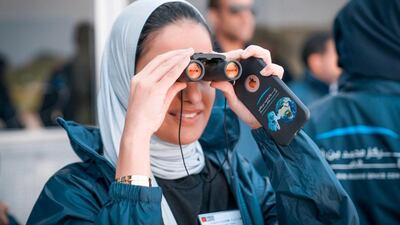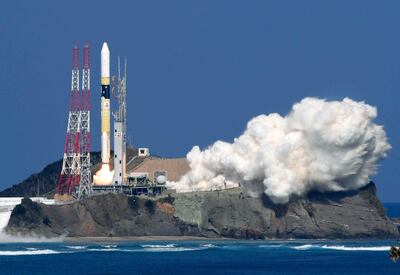Emirati women are taking advantage of the hundreds of jobs being generated by the UAE’s space programmes.
About two fifths of Mohammed bin Rashid Space Programme’s staff are women. More than a third of applicants to Khalifa University’s master’s space programme – the Middle East’s first – are female.
The figures were revealed at a Dubai event on the Youth and Future of Knowledge Economy on Thursday, which supports ambitious plans for future generations to embrace space exploration.
Interest in the UAE’s plan to explore Mars is high among women and young people. The UAE plans to launch a Mars mission probe in 2020, which would arrive on the Red Planet by 2021.
“The average age of [those employed at] the Mohammed bin Rashid Space Centre is 27 years, and about 40 per cent of the employees are female,” said Amer Al Sayegh Al Ghafi, project manager of KhalifaSat, an Emirati probe which was sent into space on October 29.
“Most are working in the technical and scientific sections.
“The UAE currently has 10 satellites, but we will develop this programme to make the country a regional leader in research and development for space technology in the next few years.
“We have to be patient, and it is more important than ever for young people to gain an interest, and retain their long-term goals if our space programmes are to be successful.”
The UAE has grand ambitions to develop a world-class engineering talent pool to fill a gap in the aerospace industry, with Emiratis being central to achieving these national goals.
Yahsat, the Abu Dhabi satellite communication company, is central to that.
It currently has Emiratisation at 64 per cent and two thirds of its staff have technical specialisations.
Yahsat has 267 employees, 170 of whom are Emirati. Well over half have technical qualifications and 33 per cent are non-technically qualified.
Of the UAE nationals working there, 28 per cent are recent graduates, with 10 working in ground engineering and 11 in the space engineering sector.
“The UAE has an impressive number of female applicants,” said Nicole Stott, an American engineer and Nasa astronaut, who was speaking at the Dubai event. “I don’t think I have seen a greater female ratio anywhere else.
“In the US we are still working very hard to get the female applicants up to 25 per cent on our space programmes. We have to engage young girls with space very early,” she said.
“By the time they are 12 or 13 we have to have generated some interest and excitement in them because we know after this age, something changes and the attraction just isn’t there.”
________________
Read more:
UAE targets mission to Mars following KhalifaSat success
We have lift-off: UAE-built MYSAT-1 successfully launched
KhalifaSat launch: UAE rulers hail 'unprecedented Emirati achievement'
__________________
In November, the UAE space programme set a new benchmark for the country by launching MYSAT-1, a CubeSat mini satellite built by students at Khalifa University.
A CubeSat is a miniaturised satellite used for space research. A master’s programme at the university focused on this technology is producing talent in a variety of fields for the UAE’s aerospace programme.
The Dubai event heard how the Emirates has a golden opportunity to make up ground in the international space race, as governments with established programmes are beginning to withdraw from long-term space exploration plans.
That has left a void that the private sector is generally reluctant to fill.
Nasa funding for the International Space Station is due to end by 2025, when it could be handed over to private operators.
“Aerospace costs a lot of money; it is high risk and it is a long-term investment,” said Mishaal Ashemimry, an aerospace engineer and founder of Mishaal Aerospace in Florida which develops cost-effective rockets.
“You are not going to see any kind of return for at least 10 years, so private investors can be reluctant to put money into aerospace programmes.
“Space is very important, and has helped us to develop technology that is now widely used today in science and medicine.
“It gives you a research environment to study something that is critical on Earth, such as osteoporosis, or to detect cancer – this is a technology that was first developed in space.
“It is the future, and something that is very important. Soon enough, a lot of us will be visiting space very often.”



